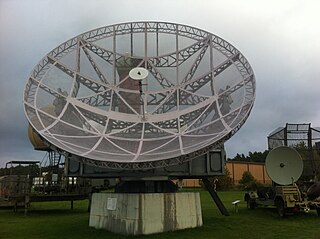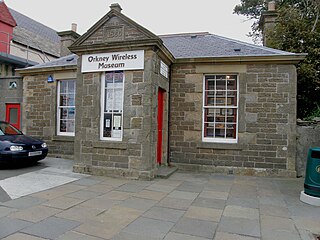
The RCA Corporation was a major American electronics company, which was founded in 1919 as the Radio Corporation of America. It was initially a patent trust owned by General Electric (GE), Westinghouse, AT&T Corporation and United Fruit Company. In 1932, RCA became an independent company after the partners were required to divest their ownership as part of the settlement of a government antitrust suit.

Signals intelligence (SIGINT) is the act and field of intelligence-gathering by interception of signals, whether communications between people or from electronic signals not directly used in communication. As classified and sensitive information is usually encrypted, signals intelligence may necessarily involve cryptanalysis. Traffic analysis—the study of who is signaling to whom and in what quantity—is also used to integrate information, and it may complement cryptanalysis.

Sir Robert Alexander Watson Watt was a Scottish pioneer of radio direction finding and radar technology.

Wireless communication is the transfer of information (telecommunication) between two or more points without the use of an electrical conductor, optical fiber or other continuous guided medium for the transfer. The most common wireless technologies use radio waves. With radio waves, intended distances can be short, such as a few meters for Bluetooth or as far as millions of kilometers for deep-space radio communications. It encompasses various types of fixed, mobile, and portable applications, including two-way radios, cellular telephones, personal digital assistants (PDAs), and wireless networking. Other examples of applications of radio wireless technology include GPS units, garage door openers, wireless computer mouse, keyboards and headsets, headphones, radio receivers, satellite television, broadcast television and cordless telephones. Somewhat less common methods of achieving wireless communications involve other electromagnetic phenomena, such as light and magnetic or electric fields, or the use of sound.

Tropospheric scatter, also known as troposcatter, is a method of communicating with microwave radio signals over considerable distances – often up to 500 kilometres (310 mi) and further depending on frequency of operation, equipment type, terrain, and climate factors. This method of propagation uses the tropospheric scatter phenomenon, where radio waves at UHF and SHF frequencies are randomly scattered as they pass through the upper layers of the troposphere. Radio signals are transmitted in a narrow beam aimed just above the horizon in the direction of the receiver station. As the signals pass through the troposphere, some of the energy is scattered back toward the Earth, allowing the receiver station to pick up the signal.
Telefunken was a German radio and television producer, founded in Berlin in 1903 as a joint venture between Siemens & Halske and the Allgemeine Elektrizitäts-Gesellschaft (AEG) . Prior to World War I, the company set up the first world wide network of communications and was the first in the world to sell electronic televisions with cathode ray tubes, in Germany in 1934.

An electronic countermeasure (ECM) is an electrical or electronic device designed to trick or deceive radar, sonar, or other detection systems, like infrared (IR) or lasers. It may be used both offensively and defensively to deny targeting information to an enemy. The system may make many separate targets appear to the enemy, or make the real target appear to disappear or move about randomly. It is used effectively to protect aircraft from guided missiles. Most air forces use ECM to protect their aircraft from attack. It has also been deployed by military ships and recently on some advanced tanks to fool laser/IR guided missiles. It is frequently coupled with stealth advances so that the ECM systems have an easier job. Offensive ECM often takes the form of jamming. Self-protecting (defensive) ECM includes using blip enhancement and jamming of missile terminal homers.

The low-UHF band Würzburg radar was the primary ground-based tracking radar for the Wehrmacht's Luftwaffe and Kriegsmarine during World War II. Initial development took place before the war and the apparatus entered service in 1940. Eventually, over 4,000 Würzburgs of various models were produced. It took its name from the city of Würzburg.

Pye Ltd was an electronics company founded in 1896 in Cambridge, England, as a manufacturer of scientific instruments. The company merged with EKCO in 1960. Philips of the Netherlands acquired a majority shareholding in 1967, and later gained full ownership.

AWA Technology Services, name based on former name Amalgamated Wireless (Australasia) Ltd, is an Australian provider for technology related services. Throughout most of the 20th century AWA was Australia's largest and most prominent electronics organisation, undertaking development, manufacture and distribution of radio, telecommunications, television and audio equipment as well as broadcasting services.

The Museum of Radio and Technology is a museum in Huntington, West Virginia.

Vintage amateur radio is a subset of amateur radio hobby where enthusiasts collect, restore, preserve, build, and operate amateur radio equipment from bygone years, such as those using vacuum tube technology. Popular modes of operation include speaking over amplitude modulation (AM), and communicating using Morse code through continuous wave (CW) radiotelegraphy. Some enthusiasts have interest in owning, restoring and operating vintage military and commercial radio equipment such as those from 1940s to 1960s. Some undertake to construct their own gear, known in ham slang as homebrewing, using vintage parts and designs. A number of amateur radio clubs and organizations sponsor contests, events, and swap meets that cater to this specialized aspect of the hobby.

Radio is the technology of communicating using radio waves. Radio waves are electromagnetic waves of frequency between 3 hertz (Hz) and 300 gigahertz (GHz). They are generated by an electronic device called a transmitter connected to an antenna which radiates oscillating electrical energy, often characterized as a wave. They can be received by other antennas connected to a radio receiver, this is the fundamental principle of radio communication. In addition to communication, radio is used for radar, radio navigation, remote control, remote sensing, and other applications.

The Paraset was a small, low-power, thermionic valve, CW-only radio transmitter-receiver supplied to the resistance groups in France, Belgium and the Netherlands during World War II.

EKCO was a British electronics company producing radio and television sets from 1924 until 1960. Expanding into plastic production for its own use, Ekco Plastics produced both radio cases and later domestic plastic products; the plastics company became Lin Pac Mouldings Ltd.

The SCR-299 was a U.S. Signal Corps mobile military communications unit used during World War II.

The Orkney Wireless Museum in Kirkwall, Orkney, Scotland, houses a collection of domestic and military wireless equipment. It developed from the private collection of the late Jim MacDonald from St Margaret's Hope and marks the importance of wireless communications in Orkney during World War II.
C. Lorenz AG (1880–1958) was a German electrical and electronics firm primarily located in Berlin. It innovated, developed, and marketed products for electric lighting, telegraphy, telephony, radar, and radio. It was acquired by ITT in 1930 and became part of the newly founded company Standard Elektrik Lorenz (SEL) Stuttgart in 1958, when it merged with Standard Elektrizitätsgesellschaft and several other smaller companies owned by ITT. In 1987, SEL merged with the French companies Compagnie Générale d'Electricité and Alcatel to form the new Alcatel SEL.

IFF Mark II was the first operational identification friend or foe system. It was developed by the Royal Air Force just before the start of World War II. After a short run of prototype Mark Is, used experimentally in 1939, the Mark II began widespread deployment at the end of the Battle of Britain in late 1940. It remained in use until 1943, when it began to be replaced by the standardised IFF Mark III, which was used by all Allied aircraft until long after the war ended.



















